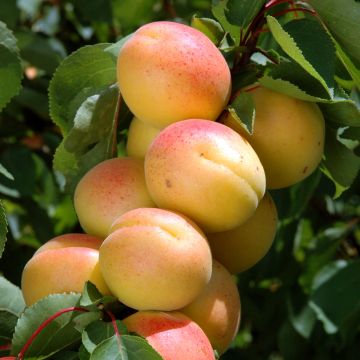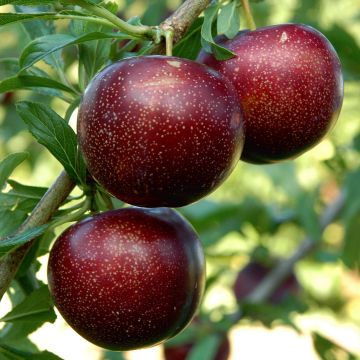

Chaenomeles japonica Cido - Flowering Quince
Chaenomeles japonica Cido - Flowering Quince
Chaenomeles japonica Cido
Japanese Quince
This item cannot be shipped to the selected country
Delivery charge from €5.90
More information
Schedule delivery date,
and select date in basket
This plant carries a 6 months recovery warranty
More information
We guarantee the quality of our plants for a full growing cycle, and will replace at our expense any plant that fails to recover under normal climatic and planting conditions.
From €5.90 for pickup delivery and €6.90 for home delivery
Express home delivery from €8.90.

Description
Chaenomeles japonica 'Cido' is a variety of Japanese quince that is both ornamental and fruit-bearing, first attracting attention with its long spring flowering of a beautiful light red-orange colour, and then with its round and fragrant fruits that are harvested when ripe, from late August to October. The size of its quinces, their golden yellow colour, and their tangy flesh rich in vitamin C, have earned this bush the nickname Northern Lemon. Harvesting the fruits is made easier by its almost thornless branches. Its pleasantly fragrant fruits can be consumed cooked, in compotes, jellies, jams, and tagines. Very cold-resistant and undemanding, 'Cido' thrives in good garden soil without excess limestone and in a sunny or semi-shaded exposure.
Chaenomeles japonica belongs to the Rosaceae family, just like apple trees and pear trees. This bush is native, as its name suggests, to Japan. The 'Cido' cultivar was selected in Latvia, where it is now grown on a large scale for fruit production. Its foliage is deciduous, appearing in spring and falling in autumn.
This relatively fast-growing shrub with a bushy habit, spreads by shoots from its stump and often forms somewhat tangled, irregular, and almost thornless branches. It will reach maturity at an average of 1.25m (4ft) in all directions, depending on the growing conditions. Flowering takes place in April-May in average climates. When the winter is mild, it can start as early as March, before the leaves appear. The flowers bloom for 4 to 6 weeks, first on bare branches, then among the young leaves. They are 3cm (1in) wide, with slightly open cups and 5 petals, with a light coral colour that is intermediate between light red and orange. They are grouped in small clusters of 3 or 4, and are borne on very short or even absent pedicels, on the previous year's branches. After pollination by bees and other insects, they give way to round fruits, 6 to 7cm (2 to 3in) in diameter, turning yellow by the end of summer. These fruits, sometimes beautifully tinged with orange, are consumed cooked. They have an aromatic, flavourful, and tangy flesh, with a higher vitamin C content than lemons. The leaves are entire, ovate to lanceolate, 3 to 6 cm (1 to 2in) long and 1.5 to 3cm (1in) wide, with a beautiful shiny green colour on their upper surface.
Japanese quinces, like Forsythias, Abeliophyllum, and Japanese kerrias, are among the first to provide beautiful spring flowers, so eagerly awaited after a long winter. This Japanese quince is a rewarding bush. It is easy to grow, decorative, and delicious. Space-saving, it can find its place even in small gardens, or in a container on a terrace or balcony. Comfortable in all climates, not fearing heat or cold, it can be planted both as a standalone specimen and in a border, and of course in a country hedge. For example, plant it with a winter honeysuckle (Lonicera fragrantissima). To save space, its branches can also be trained against a wall, on a wire frame, accompanied by a winter jasmine (Jasminum nudiflorum). Its still bare but bud-filled branches are perfect for bouquets in a tall vase.
Report an error about the product description
Chaenomeles japonica Cido - Flowering Quince in pictures


Plant habit
Fruit
Flowering
Foliage
Botanical data
Chaenomeles
japonica
Cido
Rosaceae
Japanese Quince
Cultivar or hybrid
Other Hybrid varieties
Planting and care
Chaenomeles japonica 'Cido' thrives in the sun. You can also grow it in partial shade, in sunnier regions. Plant it in ordinary, moist but well-drained soil. It will tolerate drought after 3 years of cultivation. It also tolerates limestone. It is a very easy plant to grow. When planting, mix your soil with compost. When grown as a hedge, space the plants 80cm (32in) apart. In a flower bed, the plants should be spaced 40 to 60cm (16 to 24in) apart. This Japanese quince is resistant to pollution. It requires little maintenance, apart from occasionally pruning the longest branches in spring, as they can become less floriferous. Apply well-decomposed compost to it in spring to promote fruit production.
The bush is sensitive to scab and aphids.
Planting period
Intended location
Care
-
, onOrder confirmed
Reply from on Promesse de fleurs
Haven't found what you were looking for?
Hardiness is the lowest winter temperature a plant can endure without suffering serious damage or even dying. However, hardiness is affected by location (a sheltered area, such as a patio), protection (winter cover) and soil type (hardiness is improved by well-drained soil).

Photo Sharing Terms & Conditions
In order to encourage gardeners to interact and share their experiences, Promesse de fleurs offers various media enabling content to be uploaded onto its Site - in particular via the ‘Photo sharing’ module.
The User agrees to refrain from:
- Posting any content that is illegal, prejudicial, insulting, racist, inciteful to hatred, revisionist, contrary to public decency, that infringes on privacy or on the privacy rights of third parties, in particular the publicity rights of persons and goods, intellectual property rights, or the right to privacy.
- Submitting content on behalf of a third party;
- Impersonate the identity of a third party and/or publish any personal information about a third party;
In general, the User undertakes to refrain from any unethical behaviour.
All Content (in particular text, comments, files, images, photos, videos, creative works, etc.), which may be subject to property or intellectual property rights, image or other private rights, shall remain the property of the User, subject to the limited rights granted by the terms of the licence granted by Promesse de fleurs as stated below. Users are at liberty to publish or not to publish such Content on the Site, notably via the ‘Photo Sharing’ facility, and accept that this Content shall be made public and freely accessible, notably on the Internet.
Users further acknowledge, undertake to have ,and guarantee that they hold all necessary rights and permissions to publish such material on the Site, in particular with regard to the legislation in force pertaining to any privacy, property, intellectual property, image, or contractual rights, or rights of any other nature. By publishing such Content on the Site, Users acknowledge accepting full liability as publishers of the Content within the meaning of the law, and grant Promesse de fleurs, free of charge, an inclusive, worldwide licence for the said Content for the entire duration of its publication, including all reproduction, representation, up/downloading, displaying, performing, transmission, and storage rights.
Users also grant permission for their name to be linked to the Content and accept that this link may not always be made available.
By engaging in posting material, Users consent to their Content becoming automatically accessible on the Internet, in particular on other sites and/or blogs and/or web pages of the Promesse de fleurs site, including in particular social pages and the Promesse de fleurs catalogue.
Users may secure the removal of entrusted content free of charge by issuing a simple request via our contact form.
The flowering period indicated on our website applies to countries and regions located in USDA zone 8 (France, the United Kingdom, Ireland, the Netherlands, etc.)
It will vary according to where you live:
- In zones 9 to 10 (Italy, Spain, Greece, etc.), flowering will occur about 2 to 4 weeks earlier.
- In zones 6 to 7 (Germany, Poland, Slovenia, and lower mountainous regions), flowering will be delayed by 2 to 3 weeks.
- In zone 5 (Central Europe, Scandinavia), blooming will be delayed by 3 to 5 weeks.
In temperate climates, pruning of spring-flowering shrubs (forsythia, spireas, etc.) should be done just after flowering.
Pruning of summer-flowering shrubs (Indian Lilac, Perovskia, etc.) can be done in winter or spring.
In cold regions as well as with frost-sensitive plants, avoid pruning too early when severe frosts may still occur.
The planting period indicated on our website applies to countries and regions located in USDA zone 8 (France, United Kingdom, Ireland, Netherlands).
It will vary according to where you live:
- In Mediterranean zones (Marseille, Madrid, Milan, etc.), autumn and winter are the best planting periods.
- In continental zones (Strasbourg, Munich, Vienna, etc.), delay planting by 2 to 3 weeks in spring and bring it forward by 2 to 4 weeks in autumn.
- In mountainous regions (the Alps, Pyrenees, Carpathians, etc.), it is best to plant in late spring (May-June) or late summer (August-September).
The harvesting period indicated on our website applies to countries and regions in USDA zone 8 (France, England, Ireland, the Netherlands).
In colder areas (Scandinavia, Poland, Austria...) fruit and vegetable harvests are likely to be delayed by 3-4 weeks.
In warmer areas (Italy, Spain, Greece, etc.), harvesting will probably take place earlier, depending on weather conditions.
The sowing periods indicated on our website apply to countries and regions within USDA Zone 8 (France, UK, Ireland, Netherlands).
In colder areas (Scandinavia, Poland, Austria...), delay any outdoor sowing by 3-4 weeks, or sow under glass.
In warmer climes (Italy, Spain, Greece, etc.), bring outdoor sowing forward by a few weeks.











































